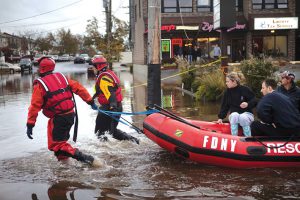Hurricane Sandy swept through New York City in October 2012 leading to 43 deaths and an estimated $19 billion in damages. The fallout devastated city residents as their homes, along with the city’s public transit system, were submerged in water.
A decade later, the city is still rebuilding after the superstorm as it confronts the threat of extreme weather. New York needs to step up its efforts and spend the $15 billion in federal grants that it received for recovery efforts, a new report by New York City Comptroller Brad Lander released on Thursday said. As of June 2022, it has only used 73% of those funds, the report said.
“The climate crisis is moving far faster than we are,†Lander said in an emailed statement. “Superstorm Sandy was a wake-up call for the devastating risks that climate change poses to our city – but from the trudging pace of too many resiliency projects, it seems like we’re still asleep. Without significant improvements to infrastructure design and delivery, New York City will fail to get ready in time for the next storm.â€
In 2021, the nation’s largest city was not prepared and was yet again temporarily paralyzed by a storm that first pummeled distant New Orleans. Hurricane Ida, which halted the city’s transit system and killed more than 40 people in the city and surrounding suburbs, conjured a future constrained by recurrent disasters.
While New York is slated to receive $188 million new federal money for Hurricane Ida recovery and over $1 billion via the Infrastructure Investment and Jobs Act, the report said, more needs to be done and fast.
According to the report, dangerous storms will put about $242 billion of property at risk of coastal flooding by the 2050s. But neither Sandy nor rising tides scared real estate developers or homebuyers away from the waterfront. In fact, since 2012, real estate market rate values in the 100-year floodplain, areas in the city where there is a 1% chance of flooding in any given year, have increased to over $176 billion from $122 billion.
—Bloomberg
 The Gulf Time Newspaper One of the finest business newspapers in the UAE brought to you by our professional writers and editors.
The Gulf Time Newspaper One of the finest business newspapers in the UAE brought to you by our professional writers and editors.
